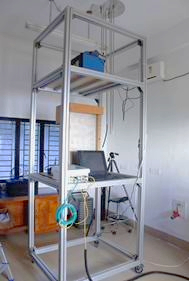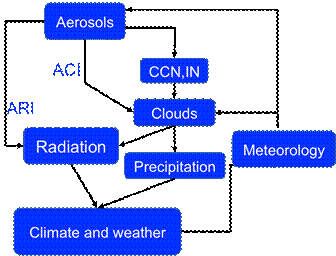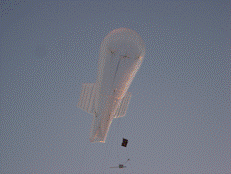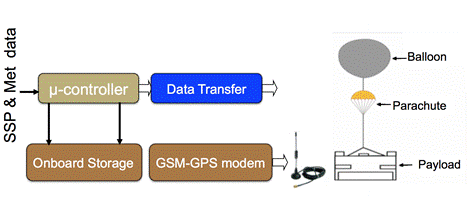The Atmospheric Science group comprises three faculty members engaged in both numerical modeling and observational studies of the atmosphere. Their primary focus lies in enhancing mesoscale model performance through the assimilation of non-conventional data sources, including satellite observations, using advanced data assimilation techniques.
Group members also have expertise in deploying and analyzing data from atmospheric boundary layer towers to address key scientific questions. One faculty member specializes in aerosol measurements and investigates their impact on cloud microphysics and the radiation budget, particularly in the context of climate change.
The group’s research spans several thrust areas: monsoon climate studies, climate and mesoscale modeling, data assimilation, aerosols and their role in climate change, radiation–climate interactions, atmospheric boundary layer processes, the use of unmanned aerial vehicles (UAVs) as research platforms, and the development of miniaturized instrumentation for space applications. Recently, the group has also incorporated machine learning (ML) techniques to advance research across these domains.
Key Research Areas:
- Atmospheric Modelling
- Data assimilation & Weather Predictability
- Aerosols and climate interactions
- Radiation–climate interactions
Studying Atmospheric Science in IIST
IIST currently admits students through the Advanced JEE examination into a five-year dual degree program, which awards a BTech in Engineering Physics and an MTech in Earth System Science. During the fourth and fifth years of this program, students focus on specialized courses in Atmospheric Science and Geology. Additionally, the institute offers a separate two-year MTech program in Earth System Science, open to graduates with an engineering degree or an MSc. This program includes one year of academic coursework followed by a year devoted to independent research culminating in an MTech thesis.
Research Facilities:
The Ponmudi Climate Observatory (PCO), operated by the IIST, is a premier research facility located atop the Western Ghats in Kerala at an elevation of 1,000 meters above mean sea level (8.76°N, 77.12°E). This high-altitude site offers a unique environment for atmospheric studies, particularly during the summer monsoon season when it is often enveloped by clouds, providing an ideal natural laboratory for investigating aerosol-cloud interactions and other atmospheric processes. Key Research Facilities at PCO include Aerosol Instrumentation, LIDAR Ceilometer, Cloud Condensation Nuclei Counter, Micro Rain Radar, Disdrometer etc. In addition to this, access to high-performance computing clusters are available for Atmospheric Modelling studies.

Research Facilities @ IIST Ponmudi Climate Observatory
IIST has established a Climate Observatory at its Ponmudi Campus on the hilltop of the Western Ghats (PCO, 8.76°N, 77.12°E, 1 km, AMSL). It is equipped with state-of-the-art field instrumentation for measuring aerosol and cloud microphysics along with meteorological variables. Over the years, many observational campaigns covering greenhouse gases (GHG), meteorology, boundary layer, aerosol-cloud interactions, and radiation balance studies have been carried out by the faculty of IIST. These instruments are also extensively used for lab and teaching courses at IIST.

IIST Balloon Launch Facility
Atmospheric research is one of the strongholds of IIST, with a fully owned and dedicated research facility at PCO. The observatory is one of its kind in the country, with provisions for balloon-borne measurements from near-surface to stratosphere (35 km) in the frontiers of Atmospheric Sciences, Astronomy, Astrobiology, high energy Physics, and space technology development. Students/faculty at IIST may be encouraged to build and quickly test payloads and conduct high quality research in the lower Earth's atmosphere.
A new collaborative program on the measurement of vertical profile of ozone along with meteorological parameters at multiple sites (Ponmudi, Hyderabad, Nagpur, Jodhpur) has been initiated under the coordination and support of the Earth & Climate Area (ECSA) of the National Remote Sensing Centre (NRSC/ISRO). As part of this study, coordinated monthly launches are undertaken at four sites.
Balloon launch from Ponmudi Climate Observatory
Tethered balloons for testing small payloads up to 1 km altitude
Tethered balloons of volume 9.0 m3 capable of carrying 1.0-3.0 kg payload weight up to an altitude of about 1 km are also available for conducting various scientific experiments

Small payload development for space research
A frequent access to space for university groups like IIST to make small autonomous payloads that will perform high-quality scientific investigations has become available with the maturing of the ISRO launch capabilities. This, in turn, requires training of graduate students, young scientists and engineers in “hands-on” research techniques used in space experiments. Student satellite (Studentsat) program (SSP), which is a balloon-based interdisciplinary program, provides an educational experience to students, young scientists, and engineers in the design and data analysis of a space experiment (up to 35 km). Studentsat can have a compendium of lightweight payloads (sensors) for remote sensing, atmospheric sciences, biology, chemistry, and astronomy designed by students within the mass and power constraints. It offers opportunities to have hands-on experience on complex processes of design, development, testing, and integration of state-of-the-art sensors to probe the space environment and data analysis. It provides an affordable way to acquire the basic knowledge and many challenges in building a payload for space research and technological development. It offers an opportunity to the space scientist to gain the first experience of the real space mission program, starting with design, testing, integration, launching, data analysis, and presentation of results. It offers the students (undergraduate and postgraduate students and Ph.D.) to design and build a small scientific satellite payload to gain first-hand experience of the actual space mission program /planetary exploration and nurture future space scientists and engineers in the country.



